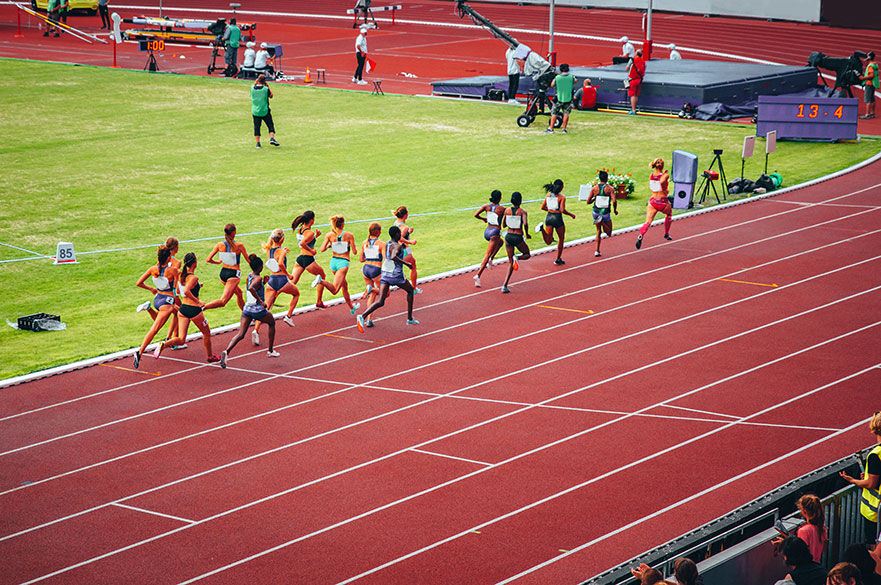Expert blog: What the Caster Semenya Judgment could mean for gender policy in sport
Associate Professor Seema Patel, an expert in sports law at Nottingham Law School, examines the upcoming Grand Chamber judgment in Semenya v Switzerland and its potential impact on gender eligibility and human rights in sport.
By Associate Professor Seema Patel | Published on 25 June 2025
Categories: Press office; Research; Nottingham Law School;

We are at the centre of a sex and gender storm. Conceptual definitions of sex are having significant practical implications on rights and access to services for gender diverse groups, with a targeted focus on trans people.
In the UK, the UK Supreme Court Ruling on the definition of sex in the Equality Act 2010 in May 2025 has caused shock waves for gender rights and major disruption to single sex spaces. The implications for sport remain uncertain with public consultation taking place to understand what this Ruling means in practice.
While in the USA, the new Trump administration has pushed down on gender identity and removed protections for trans people, including an executive order that prevents trans females from competing in female categories of sports signed by President Trump.
These legal hammers in the UK and the USA are influencing sports bodies to tighten gender eligibility policies and confine the female categories to birth sex, with a general trend towards the exclusion of trans female athletes.
Views continue to differ on the correlation between binary sex categories, the effects of testosterone on sport performance, physiological advantage, safety, injury risk and gender diversity.
Against this background, on 10 July 2025 the Grand Chamber of the European Court of Human Rights (ECtHR) will finally deliver its Judgment in the case of Semenya vs Switzerland.
Caster Semenya is a world class South African runner who was restricted from competing in athletics by the World Athletics (WA) Eligibility Regulations 2018, which place medical conditions upon females with differences of sexual development (DSD), to participate in the female category.
Semenya challenged the eligibility requirement to undergo hormone treatment to lower her naturally elevated testosterone levels connected to her DSD identity, on the grounds that the rules constituted birth, sex and gender discrimination. WA defends the DSD regulations as necessary, reasonable and proportionate to maintain fair competition in the female category.
Semenya was unsuccessful before the Court of Arbitration for Sport (CAS) (in 2019) and the Swiss Federal Supreme Court (SFT) (in 2020). She fought her way to the European Court of Human Rights (ECtHR) and in 2023 it held by a majority that there had been a violation of European Convention of Human Rights (ECHR) Article 14 (prohibition of discrimination), taken together with Article 8 (respect to private life), and Article 13 (right to an effective remedy), taken together with Article 8 and Article 14 (prohibition of discrimination), by failing to secure safeguards in the review of Semenya’s case.
The Chamber highlighted that Semenya complained of the violation of her Convention rights to the CAS and the SFT but neither reviewed those matters sufficiently, owing to its limited powers.
In 2023, the Swiss Government requested a referral to the Grand Chamber, which was accepted by the Panel. The Grand Chamber hearing took place in May 2024 to assess the compatibility of the case with Convention rights, and the Judgment is imminent.
The ECHR is often celebrated as a living instrument that is interpreted in light of present-day conditions. As outlined, those present-day conditions are turbulent and this outcome is likely to ignite further discussion about sex and gender in sport, with a risk of conflating DSD and trans athletes.
For example, since the Chamber Judgment in 2023, WA has imposed further restrictions on gender eligibility and in March 2025, it announced the re-introduction of a sex test to determine eligibility in the female category, in the form of a cheek swab gene test. It also recommended the merging of DSD and trans athlete policies which was warned against in the Chamber Judgment.
The eligibility of DSD athletes is somewhat overshadowed by the trans female debates but has nonetheless attracted athlete challenges for many years. The inclusion of both groups in the female sport category challenges binary categories and both are subject to similar scrutiny over testosterone, performance advantage, safety and injury risks.
When it comes to law and sport regulation there is an urgent need to identify areas of overlap as well as key distinctions between DSD and trans people.
The Grand Chamber Judgment will come at a time when gender eligibility is at its most contentious, and most politically charged. However, it might assist in encouraging dialogue and clarifying the legal and sport position for DSD athletes.
If the Grand Chamber confirms the Chamber Judgment it might have a significant influence on the future adoption of human rights in sport regulation and sport disciplinary processes. The compatibility of domestic law and sports rules with Convention rights might be subject to closer scrutiny following this Judgment.
Dr Seema Patel, Associate Professor in Law, Nottingham Law School
Notes for Editors
Press enquiries please contact Helen Breese, Public Relations Manager, on telephone +44 (0)115 848 8751, or via email.
Associate Professor Seema Patel is available for media comment on the Semenya vs Switzerland Judgment and other topics related to discrimination in sport.